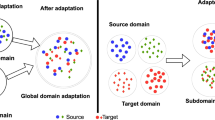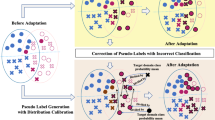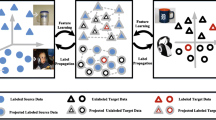Abstract
The supervised learning paradigm assumes in general that both training and test data are sampled from the same distribution. When this assumption is violated, we are in the setting of transfer learning or domain adaptation: Here, training data from a source domain, aim to learn a classifier which performs well on a target domain governed by a different distribution. We pursue an agnostic approach, assuming no information about the shift between source and target distributions but relying exclusively on unlabeled data from the target domain. Previous works [2] suggest that feature representations, which are invariant to domain change, increases generalization. Extending these ideas, we prove a generalization bound for domain adaptation that identifies the transfer mechanism: what matters is how much learnt classier itself is invariant, while feature representations may vary. Our bound is much tighter for rich hypothesis classes, which may only contain invariant classifier, but can not be invariant altogether. This concept is exemplified by the computer vision tasks of semantic segmentation and image categorization. Domain shift is simulated by introducing some common imaging distortions, such as gamma transform and color temperature shift. Our experiments on a public benchmark dataset confirm that using domain adapted classifier significantly improves accuracy when distribution changes are present.
Access this chapter
Tax calculation will be finalised at checkout
Purchases are for personal use only
Preview
Unable to display preview. Download preview PDF.
Similar content being viewed by others
References
Arnold, A., Nallapati, R., Cohen, W.W.: A comparative study of methods for transductive transfer learning. In: ICDM Workshop on Mining and Management of Biological Data (2007)
Ben-David, S., Blitzer, J., Crammer, K., Pereira, F.: Analysis of representations for domain adaptation. In: NIPS (2007)
Bickel, S., Brückner, M., Scheffer, T.: Discriminative learning for differing training and test distributions. In: ICML. ACM Press, New York (2007)
Blitzer, J., Crammer, K., Kulesza, A., Pereira, F., Wortman, J.: Learning bounds for domain adaptation. In: NIPS (2007)
Blitzer, J., Mcdonald, R., Pereira, F.: Domain adaptation with structural correspondence learning. In: Proceedings of the 2006 Conference on Empirical Methods in Natural Language Processing, Sydney, Australia (2006)
Chapelle, O., Schölkopf, B., Zien, A. (eds.): Semi-Supervised Learning. MIT Press, Cambridge (2006)
Leistner, C., Saffari, A., Santner, J., Bischof, H.: Semi-supervised random forests. In: ICCV (2009).
Dai, W., Yang, Q., Xue, G.-R., Yu, Y.: Boosting for transfer learning. In: ICML, New York, NY, USA (2007)
Triggs, B., Moosmann, F., Jurie, F.: Fast discriminative visual codebooks using randomized clustering forests. In: NIPS (2006)
Huang, J., Smola, A.J., Gretton, A., Borgwardt, K.M., Sch?olkopf, B.: Correcting sample selection bias by unlabeled data. In: NIPS (2006)
Mansour, Y., Mohri, M., Rostamizadeh, A.: Domain adaptation with multiple sources. In: NIPS (2009)
Schweikert, G., Widmer, C., Scho”lkopf, B., Ra”tsch, G.: An empirical analysis of domain adaptation algorithms for genomic sequence analysis. In: NIPS (2008)
Shotton, J., Johnson, M., Cipolla, R.: Semantic texton forests for image categorization and segmentation. In: Forsyth, D., Torr, P., Zisserman, A. (eds.) ECCV 2008, Part IV. LNCS, vol. 5305, Springer, Heidelberg (2008)
Vapnik, V.N.: Statistical Learning Theory. Wiley-Interscience, Hoboken (1998)
Author information
Authors and Affiliations
Editor information
Editors and Affiliations
Rights and permissions
Copyright information
© 2011 Springer-Verlag Berlin Heidelberg
About this paper
Cite this paper
Vezhnevets, A., Buhmann, J.M. (2011). Agnostic Domain Adaptation. In: Mester, R., Felsberg, M. (eds) Pattern Recognition. DAGM 2011. Lecture Notes in Computer Science, vol 6835. Springer, Berlin, Heidelberg. https://doi.org/10.1007/978-3-642-23123-0_38
Download citation
DOI: https://doi.org/10.1007/978-3-642-23123-0_38
Publisher Name: Springer, Berlin, Heidelberg
Print ISBN: 978-3-642-23122-3
Online ISBN: 978-3-642-23123-0
eBook Packages: Computer ScienceComputer Science (R0)




